Last May, an Egyptian archaeological mission was excavating in Saqqara’s Bubasteum necropolis, when they found something that they had never seen before.
“What is this? Is it a roll? No, it is a papyrus,” the surprised team shouted. “Look, it is wrapped in linen.”
The ecstatic team rushed to the Egyptian Museum in Tahrir to let the restorers in the laboratory deal with the precious new discovery.
They found the first ever complete papyrus discovered by Egyptians in 120 years. This 16-metre papyrus now takes pride of place among treasures in the Egyptian Museum.
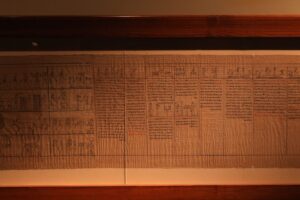
On the first floor, the papyrus adorns the wall as the first papyrus uncovered in Saqqara, south of Cairo. It dates back to the beginning of the Ptolemaic era (300 BC).
It is also the longest and most complete papyrus of the Book of the Dead written in hieratic script.
The Book of the Dead is an ancient Egyptian funerary text written on papyrus and used from the beginning of the New Kingdom (c. 1550- c. 50 BC).
It includes magic spells to help the deceased on his journey through the underworld to the afterlife. It was written by many priests over a period of about 1,000 years.
Dubbed Waziry One, the papyrus was found by the Egyptian mission led by Mostafa Waziry, secretary general of the Supreme Council of Antiquities (SCA), during the excavations in a coffin of a person called Ahmose.
“We found the papyrus in a burial site 12 metres deep,” site supervisor and archaeologist Ahmed Zikrey said.
“We opened the coffin and found the papyrus near the mummy,” he added.
“The work of opening the papyrus needs extreme care for fear of not being broken. The papyrus is sterilised to get rid of insects and bacteria. Then it is moisturised to make it easy to open,” he told the Egyptian Mail.
A few months later, it was rolled out flat. The text was transliterated into hieroglyphic script and translated into Arabic.
“Fortunately the burial site was dry, which kept the papyrus in good condition,” Zikrey said.
“We registered it in the name of Waziry, after the head of the mission,” he said.
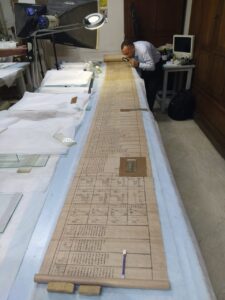
“Previously, papyri were named after the foreigners or foreign teams — Harris, Turin, Ebers and Greenfield — who found them. So we are proud that this is the first ever papyrus named after an Egyptian.”
Another papyrus is expected to see the light of day soon.
“Some weeks ago, we found ‘Waziry Two’ Papyrus in the same burial site but in another coffin, probably one of Ahmose’s relatives. The restoration team in Tahrir is now sterlising and moisturising it.”
Saqqara spans along the edge of the desert plateau for about eight kilometres, bordering Abu Sir to the north and Dahshur to the south.
Here stands the oldest pyramid, the Step Pyramid of Djoser, built during the third dynasty (2670-2650 BC). It was a necropolis of Memphis, the first capital of ancient Egypt and is the country’s largest archaeological site.
“There are more than 25 Egyptian and foreign missions working there between September and May, which is the best time to dig,” Zikrey said.
“Saqqara necropolis still has more treasures waiting to be discovered,” he added.
The 150-column papyrus begins with an empty space of about 40 cm, then a large illustration of Ahmose worshipping Osiris.
It is believed that Ahmose is of a high official rank, which was clear from his well-preserved papyrus.
“We are continuing excavation at the site to explore more details about him.”
Waziry, secretary general of the SCA, said: “We were eager to know its content and its condition. The restorers work every day and I follow them. They say we open 10 centimetres, the next day 20, then 40cm… until it reaches 16 metres. What a wonderful feeling!” he told the ambassadors and media at an event held Monday night to celebrate the completion of the first phase of the Egyptian Museum’s development. The event also marked the display of the papyrus.
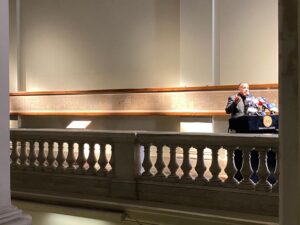
Proudly standing next to the long papyrus, he explains it tackles the stages when the deceased enters the tomb, then stands in front of Ra, the king of the deities and the father of all creation, then his journey, then the judgement and weighing of the heart to judge the worthiness of his soul, then the rebirth in the other world.
Waziry added that Ahmose appeared on the papyrus about 260 times. The papyrus is written in black ink for most of the texts, while there are some texts in red ink.
“It contains 113 spells from the Book of the Dead, the largest number of spells compared to the previously discovered papyri,” Waziry said.
A book will be published soon providing all the details about the discovery of the papyrus and the text, he added.
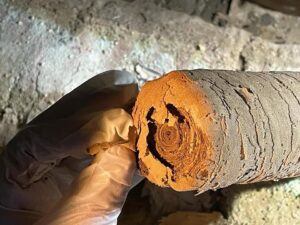
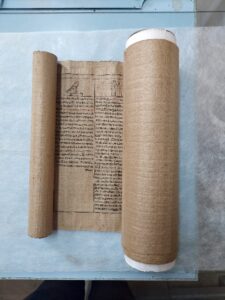
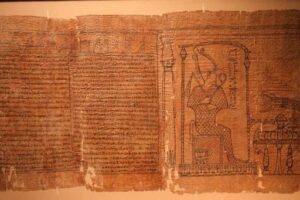






Discussion about this post